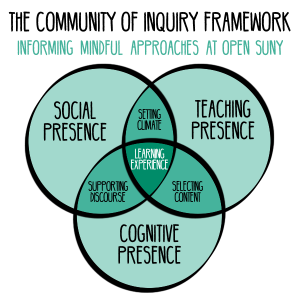Develop Mindful Approaches
SUNY Online Teaching promotes and supports excellence in online teaching and learning, contributing to and relying on evidence-based research to inform our approaches to and recommendations for online faculty development, online course design and delivery, and online learner success. Social constructivist education theory and the Community of Inquiry (CoI) model serve as the theoretical framework on which our understanding of how people teach and learn best online is built.
 The CoI framework identifies and explores three key elements that support learner engagement and promote a successful online learning environment – social, teaching and cognitive presences. Along with each presence, the CoI research provides categories with indicators to identify and define related applied effective practices, and inform the way we teaching online to best serve our online learners.
The CoI framework identifies and explores three key elements that support learner engagement and promote a successful online learning environment – social, teaching and cognitive presences. Along with each presence, the CoI research provides categories with indicators to identify and define related applied effective practices, and inform the way we teaching online to best serve our online learners.
The concepts presented here serve to inform the SUNY Online Teaching course design and teaching approaches, and may help you better understand what it means to develop a mindful approach to the design, development, and teaching of a learner-centered online course.
SOCIAL PRESENCE
Social presence is defined as the establishment of a supportive learning community, providing a venue for communication within a trusted environment where learners can express individual identities and establish social relationships (Garrison, Anderson, & Archer, 2000).
Social presence relies on establishing a welcoming online learning space, as well as acknowledging each individual learner as a valued member of the learning community.
Online instructors foster social presence by:
- Setting a welcoming tone in the course to invite learners to engage and interact with the course content, other students, and the instructor.
- Sharing biographical and professional information.
- Providing open channels for conversation and interaction that support risk-free expression.
- Encouraging collaboration within activities and assignments.
- Establishing a space for open dialogue
- Being available and responsive to learner communication.
| This video explores social presence, and how it relates to establishing a community of learners.
(2 minutes) |
TEACHING PRESENCE
Teaching presence is defined as the process of design, facilitation, and direction throughout the learning experience in order to realize desired learning outcomes (Garrison et al., 2000).
Teaching presence relies on course design quality and instructor feedback, as well as establishing a learning pathway in alignment with learning objectives, and actively guiding students along that pathway.
Online instructors foster teaching presence by:
- Designing easy to navigate, modular courses.
- Creating advance organizers and overviews to introduce students to new material.
- Providing continuous feedback to keep students on track.
- Confirming student understanding through assignment feedback.
- Facilitating dialogue and keeping discussions and conversation on topic.
- Reinforcing key learning concepts through all communication channels.
| This video explores how both students and instructors can contribute teaching presence in an online course.
(2 minutes) |
COGNITIVE PRESENCE
Cognitive presence is defined as the design and development of instructional materials, enabling students to construct and confirm meaning through related reflection and discourse (Garrison et al., 2000).
Cognitive presence relies on critical thinking skills and active learning, as well helping students to connect existing ideas and create new knowledge.
Online instructors foster cognitive presence by:
- Contextualizing course content to help learners better understand key concepts.
- Bringing in diverse resources to help learners.
- Guiding learners to move from low-order to high-order thinking exercises.
- Aligning course assignments and activities to measurable learning objectives.
| In this video, Bill Pelz shares his ideas about cognitive presence and the Community of Inquiry.
(4 minutes) |
REFERENCES
Garrison, D.R., Anderson, T., & Archer, W. (2000). Critical inquiry in a text-based environment: Computer conferencing in higher education. The Internet and Higher Education, 2(2-3), 87-105.
MORE TO EXPLORE
The Community of Inquiry Framework
This interactive web-site highlights published research about the Community of Inquiry Framework and provides opportunities to discuss these publications with researchers and practitioners. This is the most extensive collection of research and applied effective practices related to the framework.
https://coi.athabascau.ca/
Tips for Building Social Presence in Your Online Class
By focusing only on content, new online instructors often forget about the social aspects that engage students and foster community building. This article offers five ways you can build social presence in your online class.
http://www.facultyfocus.com/articles/online-education/tips-for-building-social-presence-in-your-online-class/
Social Presence
Social presence in online instruction broken down with tips, recommendations, and examples.
https://www.youtube.com/playlist?list=PL4774D4B83AF5DF41
The Community of Inquiry Model of the EduTech Wiki
The EduTech Wiki serves as a community member generated resource kit about educational technology and related fields. This site links out to additional related resources.
http://edutechwiki.unige.ch/en/Community_of_inquiry_model
